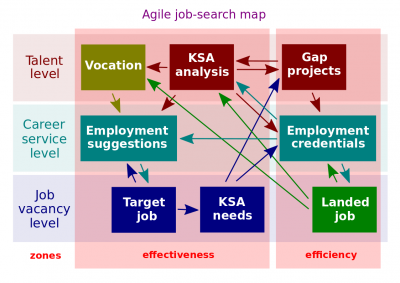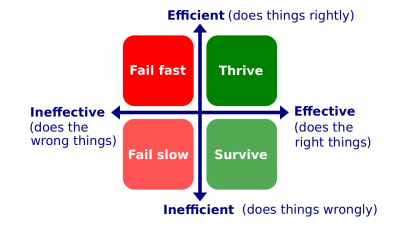Difference between revisions of "Career Essentials"
(→Career administration model) |
(→Job seeker vs entrepreneur) |
||
| Line 14: | Line 14: | ||
===Job seeker vs entrepreneur=== | ===Job seeker vs entrepreneur=== | ||
| − | :Every [[career]] can also be defined as an enterprise which objective is one's employment. We may easily compare every person who is looking for a job or may consider looking for a job | + | :Every [[career]] can also be defined as an enterprise which objective is one's employment. We may easily compare every person who is looking for a job or may consider looking for a job with a business in search for its customers. That business has the name, which is the person's name, it has some [[weakness]]es, [[strength]]s, [[threat]]s, and [[opportunity|opportuniti]]es, as well as advantages and disadvantages. Eventually, that person's time has some price too. This price is called [[employee compensation]]. |
:If one is looking for a job, he or she is an [[entrepreneur]]. [[Employment candidate]]s are [[self-employed]] and, in most cases, the goal of the business is to sell their time. Whatever is good for an enterprise is good for [[employment candidate]]s. [[Career administration]] can be viewed as no more than an application of [[business administration]] to one's [[career]]. | :If one is looking for a job, he or she is an [[entrepreneur]]. [[Employment candidate]]s are [[self-employed]] and, in most cases, the goal of the business is to sell their time. Whatever is good for an enterprise is good for [[employment candidate]]s. [[Career administration]] can be viewed as no more than an application of [[business administration]] to one's [[career]]. | ||
Revision as of 02:57, 27 January 2019

Career Admin Essentials is the first presentation in the Introduction to Careers lecture. The lecture itself is the fourth in WorldOpp Orientation. Consequently, the Orientation is the first stage of WorldOpp Pipeline.
This wikipage presents its full script and those test questions that are related to that presentation.
Contents
Script
The video of the presentation is published at https://youtu.be/Lqz0dcn9CRo (6:14). Here is its full text.
Overview
- Welcome to Career Admin Essentials. In this brief presentation, we are going to define career administration and take a look at those actions that employment candidates can take in order to land promising jobs. Let's takeoff.
What career administration is
- Career administration is a set of endeavors undertaken in order to administer one's career.
Job seeker vs entrepreneur
- Every career can also be defined as an enterprise which objective is one's employment. We may easily compare every person who is looking for a job or may consider looking for a job with a business in search for its customers. That business has the name, which is the person's name, it has some weaknesses, strengths, threats, and opportunities, as well as advantages and disadvantages. Eventually, that person's time has some price too. This price is called employee compensation.
- If one is looking for a job, he or she is an entrepreneur. Employment candidates are self-employed and, in most cases, the goal of the business is to sell their time. Whatever is good for an enterprise is good for employment candidates. Career administration can be viewed as no more than an application of business administration to one's career.
Career administration model
- Let's take a look at the rational career-administration model. This model describes the process of landing one's employment that rationally carries out best option valuation and maximizes the outcomes from the employment. The model has three levels. The talent level is on the top. The career service level is in the middle. The job vacancy level is on the bottom.
- Every employment is the match between employers and employees. Employees offer their talents and employers offer jobs. Talents are on one side and job vacancies are on another side.
- On a casual market, products are rarely sold without intermediaries. In most cases, something or someone should be in between employers and employees. That is why career service level is added. It includes everything and everyone who can help to match these two parties. Even if talents or employers do all career services, they still need to use some tools and rely on some information. If you are a job seeker without direct connections, you can not in any meaningful way to know what jobs are available without some sources of information.
- Let's go over this model. Let's imagine someones who have some vocation, which is basically calling. Assume that they like to work with numbers and track activities. They may dream to do that for a long time if that pays well. Even if they haven't identified their calling or callings, they may have some KSAs or knowledge, skills, and abilities. Not to start from scratch, if they know like 50% of accounting, maybe it makes sense to do 50% more and to land a job as accountants to test whether accounting fits their vocation.
Someone may help you to match to your target job, sometimes it is carrier service providers, sometimes it could be you, sometimes it could be employer. Employer may just go to do job fairs or carrier fairs and try to bring you on the board.
Employment suggestions is the place which can match you to your target job. These target jobs have some KSA`s, they have some requirements. An accounting job may have some requirements that a person needs to know, for instance educational industry, be familiar with educational industry, this person needs to know debits, credits, income statements and balance sheets. So, it will be a new KSA. These KSA`s can be compared with those KSA`s which you already have and the gaps can be found. For instance, you know debits, credits but you have never done income statements, so in this case some gap projects maybe launched so you can start to concentrate on balance sheet or income statements and whatever comes it goes to employment credentials. Usually someone needs to credential you in order to get a job, so any recruiter will look for your credentials, you cannot say you know everything in a particular field, someone needs to prove it. Sometimes some employment credentials include academic degrees, some are not. When employment credentials are set up basically it can lead to land a job and interview is another credential too.
In the next we will go over employment credentials in better detail and take a look at workforce service providers and hopefully we will be ready to go to introduction to education.
- Career administration. The process or activity of running an enterprise, which objectives are (a) discovering one's vocation, (b) identifying one's target industry and/or occupation, (c) suggesting one's target employment, (d) identifying work-related competence needed for a particular position, (e) analysis of one's KSAs, (f) development of one's employment credentials, and/or (g) landing one's job in the target occupation and/or target industry.
- Vocation. A strong feeling called "calling" of suitability for a particular career or occupation.
- Career. An occupation undertaken for a significant period of a person's life and with opportunities for progress.
- Effectiveness. The degree to which an enterprise does those activities that result in achieving its goals. In other words, effectiveness is the measure of how an enterprise meets the needs of its clientele or customers.
Efficiency is doing things right; effectiveness is doing the right things. -- Peter Drucker, management consultant
- Efficiency. The degree to which an enterprise gets the most outputs from the least amount of inputs.
- Effectiveness. The degree to which an enterprise does those activities that result in achieving its goals. In other words, effectiveness is the measure of how an enterprise meets the needs of its clientele or customers.
Summary
- This concludes the Career Admin Essentials presentation. We have defined career administration and taken a look at vocations and careers. We have also used the rational career-administration model to go over endeavors that employment candidates may undertake in order to land their jobs. The special stress was made on the difference between efficiency and effectiveness in career administration. If you haven't done yet so, you are now welcome to move to Employment Credentials.
Quiz questions
- Every statement below is split into one true and one false question in the actual exam.
See also
- Employment Credentials. The second presentation in Introduction to Careers.
- Recruiters' Essentials. The last presentation in Introduction to Recruitment.


